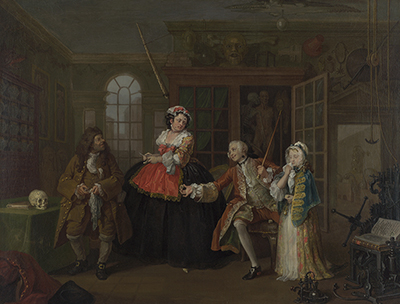William Hogarth developed a painting, the Inspection, in 1743 capturing a surgery or a consultation room. He aimed at shining light on marriage and morals through sexual exploits and the filthy greed of the aristocracy. It's a moralizing piece that satirizes the upper classes. Currently, the original art is at the National Gallery London.
In the painting, Viscount leans towards the doctor brandishing a cane with his left arm while giving a pillbox on the other hand. A child stands between his open legs and a woman in a maroon hooped dress stands beside them, who is probably the girl's mother or madam. Viscount has a black patch on his neck, signifying that he likely has contracted a sexually transmitted disease with his young mistress. The black pills resemble the mark on his neck, which Hogarth used to denote syphilis. Viscount seems discontented as the medicines failed to work, and he is probably negotiating for compensation. The consultation room contains numerous extraordinary items, including the skull on the table denoting the fate of every person in the room including the little girl dubbing a sore in the mouth as some early symptoms of the disease.
The room also contains some drawing corks, a substantial plaster head with a femur, and a spur buckler, all covered with dust, still the doctor seem puzzled of the disease. The girl looks worried and sad while in contrast, Viscount seems relaxed and unbothered by his voracious sexual appetite. The girl looks like a low borne prostitute under his pay, and Hogarth uses her to stress on the disastrous consequences of marrying for money instead of love. Hogarth used oil and canvas in the Rococo art movement to focus on the moral values in the society. He used a dense paintbrush to bring out loose strokes in a perfectly natural manner, and for finer details, the artist pressed the brush on the canvas lightly. Hogarth excellently combined rich and warm tones with lots of dark brown hues in the interior and black to complement red.
He focused on loose and free lines to create visual harmony in his paintings and give the viewer a beautiful composition. Hogarth enjoyed sketching people and objects that he observed in his daily lives. He used comic and featured people from all walks of life to portray social satire and bring moral codes to the attention of all people. He aimed at exposing the shallowness of those with more money but can't distinguish right from wrong.




